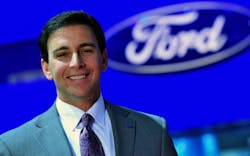So what does the future hold for light trucks? That’s becoming a tougher question to answer these days, especially as robust sales predictions now find themselves running smack into a host of negative economic reports (go here, here and here for some examples).
Still, with global oil prices low and expected to remain so for the foreseeable future, light truck sales – especially for pickups – are expected to remain strong.
“Right now the industry is red hot and we’re just getting warmed up,” noted Bill Fay, group VP and GM, Toyota division of Toyota Motor Sales U.S.A., during a presentation at the North American International Auto Show (NAIAS) last week.
“The auto business just wrapped up a historic year in 2015 with highest volume ever and vehicle sales topping 17.5 million units, surpassing last record set in 2000,” he said. “Sales have increased now for six consecutive years [and] the light truck market share has increased to about 56% of the overall market – a trend likely to continue through 2016 and possibly beyond.”Fay (at right) believes this “robust sales momentum” will continue in 2016, though Toyota expects the sales growth rate to ease in this year and in coming years.
“We predict sales to reach 17.5 million vehicles in 2016 [with a] a bull market for small SUVs [sport utility vehicles] and pickup trucks,” he explained. “Mid-size passenger car owners have moved over to light trucks largely due to [low] fuel prices [and] that trend will continue as fuel prices stay where they are at.”
Yet this market shift to light trucks – a market that’s grown by almost 3 million units last two years, Fay noted – is presenting a lot of challenges to automakers, especially in terms of meeting corporate average fuel economy (CAFE) goals.
“We’re all challenged to meet light truck CAFE requirements,” Fay said. “Everyone a little more challenged in that area. You’ll see more efforts to lightweight, more efficient engines; but we still have work to do on the light truck front. We have to deliver what interested in buying yet still meet future [fuel economy] requirements … which will increase 4% per year next 10 years. But I’m optimistic we can get there.”
One reason for Fay’s optimism centers on the success of light vehicle OEMs to date in terms of achieving better fuel economy numbers.
“Model year 2014 fuel economy is at the highest level ever, says EPA [the Environmental Protection Agency],” he pointed out. “It has grown 5 mpg [over the] last decade; a 26% increase. And for model year 2015, [the industry offers] 492 cars, trucks, and SUVs with highway fuel economy of 30 mpg and higher. So we’re balancing market demand with regulatory requirements.”But that’s only scratching the surface in terms of the change ahead for light vehicles as a group – pickups included – noted Mark Fields (at left), CEO for Ford Motor Co.
At CES 2016 – formerly the Consumer Electronics Show – in Las Vegas a couple weeks ago, Fields predicted that 2016 “will be a revolutionary year in transportation industry – we will change the way the world moves.”
He argued that, since the beginning of modern civilization, humans spent and continue to spend one to one-and-a-half hours per day traveling. But what’s changed is the distance people can travel in that timespan.
“Some 1.2 billion people spend at least 50 minutes driving per day,” Fields added, causing all sorts of unexpected havoc. For example, when looking for parking spaces (and he estimates there are 800 million around the world), drivers go slower – and that “slowdown” to hunt for a parking spot causes up to 30% of traffic congestion.
With “megacities” poised to grow – those are cities with populations in excess of 10 million – the middle class expected to double by 2030 and air pollution causing significant problems, the concept of “mobility” needs to undergo radical change, Fields argued,
“That’s why we introduced Ford Smart Mobility a year ago,” he explained. “People often ask me how does the auto industry have to change avoid being disrupted. We look at that differently, rather as opportunity to make people’s lives better. That is why we are rethinking how we approach the [automotive] business.”By that, he means Ford is looking to become an automotive and mobility company, with more attention paid to the broader concept of “transportation services” even as it maintains a focus on its core auto making business.
“Look, the ‘traditional’ automotive sales market is worth $2.3 trillion in [global] revenue, and Ford’s share is 6%,” Fields emphasized. “But the transportation services market is worth $5.4 trillion and will grow significantly over the next 15 years. Yet today, we and all our industry competitors receive none of that revenue.”
That is about to change, he stressed. “It’s a massive opportunity; we’re very serious about investing in and leading in it,” Fields noted.
That’s one reason why Ford is sticking with electronic vehicles (EVs), planning to invest $4.5 billion in that segment and bring 13 new EV models to market by 2020. “They are most popular with 30 to 40 year olds and 97%, once they try them, would use EVs again. So expect more [EV] pilots this year from us,” Fields said.
Autonomous vehicles (AVs) also remain at the forefront of Ford’s research efforts, too, but not in the way most folks think, he noted.
“We are very serious AVs as part of holistic mobility plan. Designed to serve millions of customers; not just luxury vehicles,” Fields explained. “AVs will provide ‘transportation as a service’ for non-vehicle owners such as the young, the elderly, and those who don’t want to use mass transit.”
Interesting stuff; let’s see how much of it makes it to the real world.



